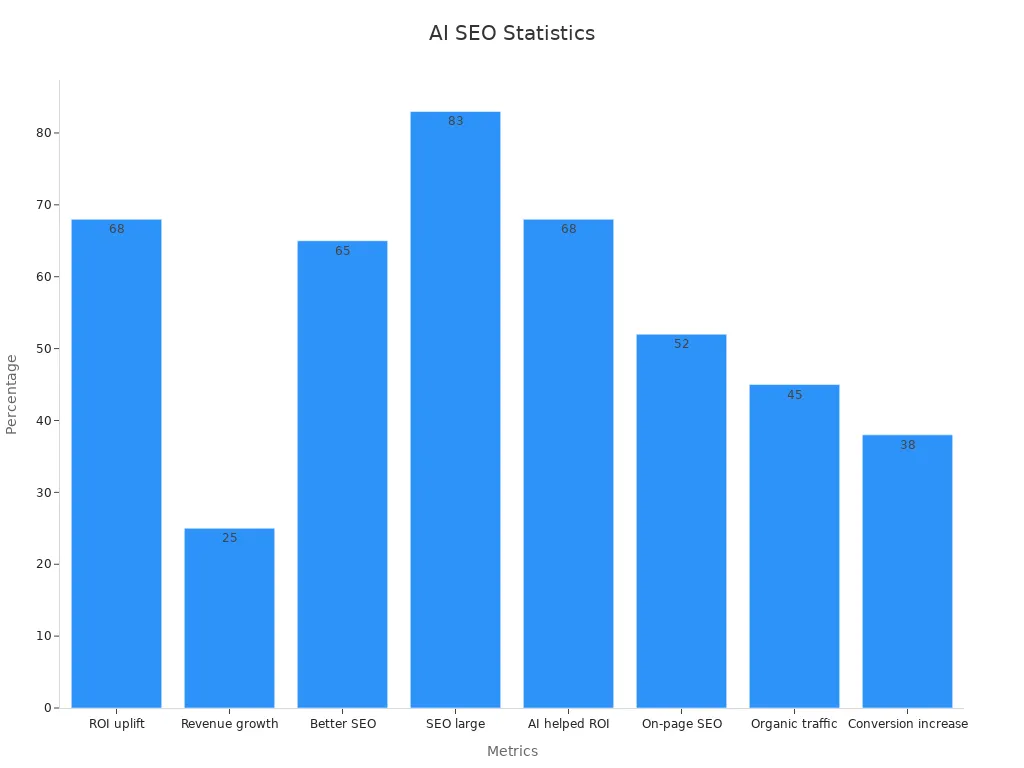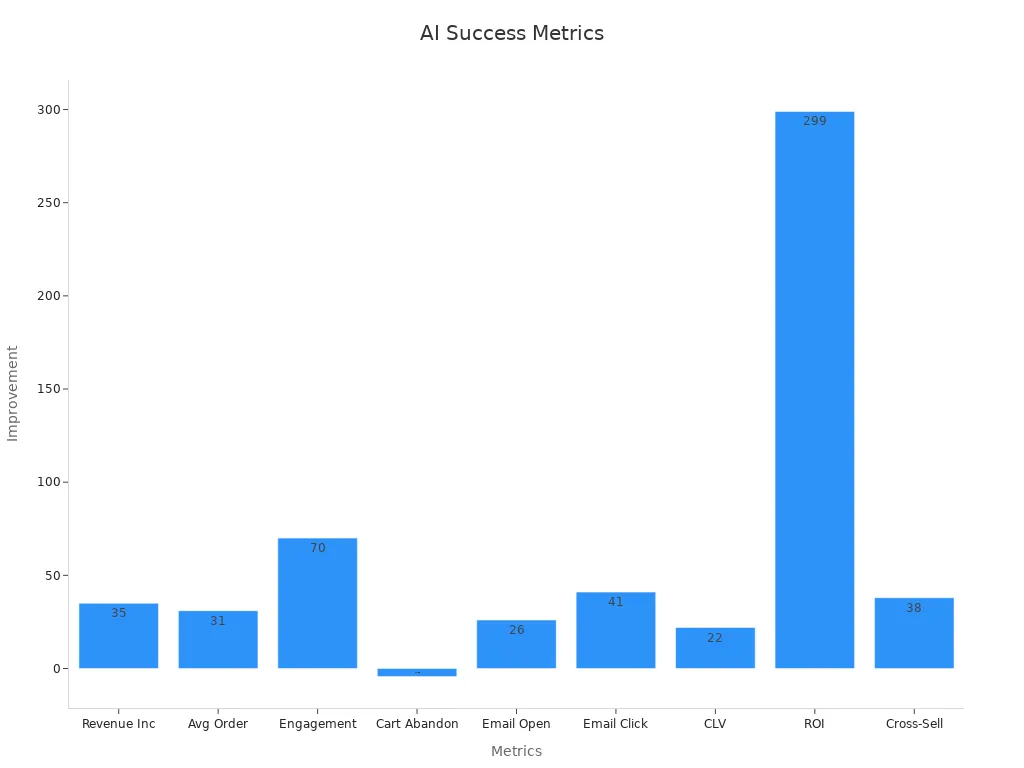AI Tools for Optimizing Blog Navigation

A smooth blog navigation helps you find information quickly and keeps you engaged. When you use AI Tools, you unlock new ways to make your blog easier to explore. These tools help organize content, suggest links, and show you what matters most. Today, many businesses see big improvements in their blogs. For example, 65% report better SEO results and 45% see more organic traffic with AI. The chart below shows how AI changes the way blogs perform for users and search engines.

With smart navigation, you can solve common problems and help visitors stay longer on your site.
Key Takeaways
AI tools improve blog navigation by making it easier for visitors to find content quickly and stay longer on your site.
Good navigation boosts user experience, lowers bounce rates, and increases engagement by helping readers explore more pages.
AI-powered features like smart search, recommendations, and automated tagging enhance SEO and drive more organic traffic.
Integrate AI tools carefully by setting clear goals, testing options, and customizing them to fit your blog’s style and audience.
Regularly monitor your blog’s performance and use AI insights to optimize navigation speed, layout, and user satisfaction.
Why Navigation Matters

User Experience
You want your blog to feel easy to use. Good navigation helps you find what you need without getting lost. When you can move through a blog smoothly, you feel more confident and enjoy your time on the site. Studies show that the way menus are placed, such as left-justified menus, makes a big difference. Left-justified menus help you find things faster and with less effort. UX professionals often look at click-through rates and user paths to see how well navigation works. These numbers show that clear menus and links reduce confusion and help you explore more pages. When you use heatmaps, you can see where people click and how far they scroll. This helps you put important content in the right spots and make your blog even easier to use.
Engagement and Retention
When you can find what you want quickly, you are more likely to stay on a blog and come back later. Research shows that blogs with strong navigation have lower bounce rates. This means visitors do not leave right away. Instead, they spend more time reading and exploring. You can use tools like heatmaps to see which menu items get the most clicks. This helps you improve your menus and keep visitors interested. Segment heatmaps also show how new and returning users behave differently. By understanding these patterns, you can create a more personal experience that keeps people coming back.
SEO Impact
Navigation does not just help users; it also helps search engines understand your blog. When you use simple menus and breadcrumbs, you make it easier for search engines to crawl your site. This can lead to higher rankings and more organic traffic. For example:
Blogs with refined navigation can see up to a 30% increase in organic traffic.
Mobile-friendly menus help keep users on your site and improve your SEO.
Using structured data and schema markup with your navigation boosts your visibility in search results.
You should always check your navigation with SEO audits and behavioral data. This way, you keep your blog easy to use and easy to find.
AI Tools Overview

AI Tools for Content Optimization
You can use AI Tools to make your blog content stronger and easier to find. These tools help you understand what your readers want. They look at how people behave, what they search for, and what topics are popular. You get help finding new topics, filling content gaps, and planning what to write next. Some tools, like Frase or Surfer SEO, suggest keywords and show you how to improve your writing for search engines. Others, such as Jasper or GrowthBar, help you draft posts and check your tone and readability.
Tip: AI Tools can save you time by automating keyword research and content planning. You can focus more on creativity and less on repetitive tasks.
Here is how AI Tools help with content optimization:
Find trending topics and content gaps.
Suggest keywords and SEO strategies.
Draft and review content for tone and readability.
Track performance and suggest updates.
Case Study | Description | Key Metrics | AI Tools Used |
|---|---|---|---|
STACK Media | Used AI-driven keyword analysis and research to optimize fitness content. | BrightEdge Data Cube, Intent Signal | |
Randy Selzer’s Real Estate | Used AI SEO tools for semantic annotation and SEO strategy. | +80% organic traffic, 700+ keywords | WordLift Plugin |
You can see that AI Tools help you get more visitors and keep them on your site longer. They also help you update old posts and improve your internal links. This makes your blog easier to explore and boosts your SEO.
Search and Recommendations
AI Tools make it easier for your readers to find what they need. These tools power smart search bars and recommendation engines. When someone types in a question, AI Tools show the most relevant posts. They also suggest related articles, products, or topics based on what the reader likes.
You can see big improvements when you use AI-powered recommendations:
People spend more time on your blog.
Shoppers often buy more when they see helpful suggestions.
Up to 30% of revenue on big sites comes from AI recommendations.
Over half of users return to blogs that offer personalized experiences.
Metric | Statistic / Impact | Source / Year |
|---|---|---|
Revenue Increase | 35% higher revenue with advanced personalization | Boston Consulting Group, 2023 |
Conversion Rate | Up to 4.5 times higher on sites with recommendations | Monetate, 2022 |
Average Order Value | 31% increase when shoppers click recommendations | Barilliance, 2023 |
Engagement (Site Session Time) | 70% longer sessions with personalized recommendations | Adobe, 2023 |
Cart Abandonment Reduction | 4.35% decrease due to recommendation systems | SaleCycle, 2022 |

You help your readers discover new content and keep them engaged. AI Tools also reduce decision fatigue by showing the best options first.
Automated Tagging
Automated tagging uses AI Tools to organize your blog posts with the right labels. These tools scan your content and pick out important topics, keywords, and categories. You do not have to tag each post by hand. This saves you time and keeps your blog organized.
With automated tagging, you get:
Better internal linking. AI Tools suggest links between related posts.
Improved SEO. Search engines understand your site structure.
Easier navigation. Readers find related posts faster.
AI Tools track how links flow through your blog. They show you which pages need more links and which ones have too many. You can use this data to balance your internal links and boost your most important pages. Some tools, like Frase, use natural language processing to suggest smart links and topic clusters.
Note: Automated tagging and internal linking help you keep your blog up to date as you add new content. You do not have to worry about missing links or outdated tags.
Chatbots and Assistance
Chatbots powered by AI Tools guide your readers and answer their questions. When someone visits your blog, a chatbot can suggest articles, help with navigation, or collect feedback. This makes your blog feel more interactive and helpful.
You can measure chatbot success with these metrics:
Measured Outcome | Description | Validation Aspect |
|---|---|---|
Bounce Rate | Tracks visitors who land on the site but do not interact with the chatbot. | Lower bounce rate indicates better user retention and engagement. |
Percent of Qualified Leads | Ratio of leads generated via chatbot to total website leads. | Higher percentage shows chatbot's effectiveness in lead qualification. |
Duration of Engagement | Time visitors spend interacting with the chatbot. | Longer engagement correlates with higher likelihood of lead conversion. |
Net Promoter Score (NPS) | Customer satisfaction score from users who engaged with the chatbot. | Higher NPS reflects excellent customer experience and user satisfaction. |
Conversion Rates | Number of leads that show interest or make a purchase through chatbot interaction. | Increased conversions demonstrate chatbot's impact on sales funnel. |
Platform Performance | Comparison of chatbot effectiveness across different platforms (e.g., website, Messenger). | Helps optimize chatbot deployment for best results. |
Conversation Transcript Analysis | Review of chat logs to identify drop-off points and improve chatbot responses. | Enables refinement of chatbot to reduce user drop-off and improve engagement. |
You can use chatbots to lower bounce rates and increase engagement. They help you collect leads and improve customer satisfaction. Chatbots also work across different platforms, so you can reach your readers wherever they are.
Implementation Steps
Tool Selection
Start by identifying what you want to improve on your blog. Make a list of problems you face, such as slow navigation or hard-to-find posts. Set clear goals, like increasing page views or lowering bounce rates. Research different AI Tools that match your needs. Look for features like easy setup, strong support, and the ability to grow with your blog. Test a few options before making a final choice. Check if the tool works well with your blogging platform and if it keeps your data safe. Read reviews and case studies to see how others use these tools. Try a pilot test to see how the tool performs in real life.
Tip: Choose a tool that fits your blog’s style and audience. Make sure it can handle more visitors as your blog grows.
Integration Process
Plan your integration by mapping out your current blog setup. Write down how your blog works now and where you want to add AI features. Build a team to help with setup, including someone who knows your blog well and someone with technical skills. Pick an AI-based integration solution that supports real-time updates and works with your data. Design your setup so it can handle more posts and visitors in the future. Test everything early to catch problems with links, menus, or search. Keep your data safe by using strong passwords and access controls. Monitor your blog after launch to spot errors and make improvements.
Step | Action |
|---|---|
1. Plan | Define goals and map current workflows |
2. Build Team | |
3. Choose Solution | |
4. Design | Create a flexible, scalable setup |
5. Test | Run tests to check links, menus, and search |
6. Secure | Use strong data protection and access controls |
7. Monitor | Watch for errors and optimize performance |
Customization
Customize your AI Tools to match your blog’s look and feel. Adjust settings so the tool uses your brand’s colors, tone, and style. Set up dynamic content optimization to test different layouts and see what works best. Personalize recommendations and search results based on what your readers like. Use privacy-friendly methods to keep user data safe while still offering a personal touch. Companies that use AI-driven personalization often see more engagement and higher revenue. Update your tool’s settings as your blog grows or your audience changes. Add your own stories or tips to make the experience unique.
Personalizing your AI Tools can help your blog stand out and keep readers coming back.
Best Practices
Maximizing Effectiveness
You can make your blog navigation stronger by following a few smart steps. Use machine learning to study how visitors move through your site. This helps you adjust menus and links so people find what they want faster. Try predictive page prerendering. This loads pages before someone clicks, making your blog feel instant. Reinforcement learning lets your site change layouts based on what works best for your readers. AI-enhanced caching keeps your blog fast by saving the right content for each user. You can also use AI to shrink images and remove extra code, which helps your blog load quickly on any device.
Analyze user behavior with machine learning
Use predictive loading for faster navigation
Optimize layouts with reinforcement learning
Improve speed with AI-driven caching and image resizing
Personalize navigation for each visitor
Tip: Uxify’s Navigation AI uses predictive loading and user behavior analysis to boost load times and improve web performance.
Monitoring Performance
You should track how well your navigation changes work. Look at how long it takes for pages to load and how often errors happen. Check if visitors stay longer and return more often. Watch for new leads and see if your blog helps you reach your goals. Use these metrics to measure your progress:
Response times and system uptime
Customer retention and satisfaction
Number of new leads and sales growth
Accuracy of AI outputs
Regular checks help you spot problems early and keep your blog running smoothly.
Real-World Examples
Case Study | AI Technologies Used | Key Features | Outcomes | Impact |
|---|---|---|---|---|
Tootle | Generative AI, NLP, Real-time API integration, Advanced Speech Technologies | Conversational interface, real-time insights | Better user experience, smarter decisions, more engagement | Set a new standard for intelligent navigation |
Tootle used advanced AI Tools to create a blog that talks with users and gives real-time information. This made it easier for people to find what they need and stay longer on the site. You can follow this example to make your own blog navigation smarter and more helpful.
You can transform your blog navigation with AI Tools. These tools help you create a better user experience, boost engagement, and improve SEO. Many fields see strong results with AI, as shown below:
Evidence Type | Description | Outcome/Statistic |
|---|---|---|
Adaptive Learning Improvement | AI tailored to individual needs | |
Intelligent Tutoring System | AI tutoring for students | 30% grade improvement, 20% less anxiety |
AI Teaching Assistant | AI chatbot answering questions | 97% success rate |
Predictive Analytics in Education | AI predicts and helps at-risk students | 80% accuracy, 34,712 students helped |
AI in Accessibility | AI tools for hearing-impaired students | 95% employment success |
AI Language Practice | AI voice technology for English practice | 800,000+ students improved |
Try using AI Tools on your blog. Share your experiences or questions in the comments below!
FAQ
What are the main benefits of using AI tools for blog navigation?
You get faster navigation, smarter content suggestions, and better organization. AI tools help you find posts quickly and keep your blog updated. You also improve SEO and user experience.
How do AI tools suggest internal links?
AI tools scan your content and find related topics. They suggest links to other posts that match keywords or themes. This helps you connect articles and guide readers through your blog.
Can I use AI tools on any blogging platform?
Most AI tools work with popular platforms like WordPress, Wix, and Squarespace. You should check the tool’s compatibility before installing. Some tools offer plugins or easy integration steps.
Do AI chatbots replace human support on blogs?
AI chatbots answer common questions and guide visitors. You still need human support for complex issues. Chatbots help you save time and improve basic user interactions.
See Also
Proven Techniques To Enhance Blog SEO Performance Effectively
Complete 2024 Guide To Perfecting Blog Content SEO
Stepwise Approach To Improve Blog Mobile User Experience

